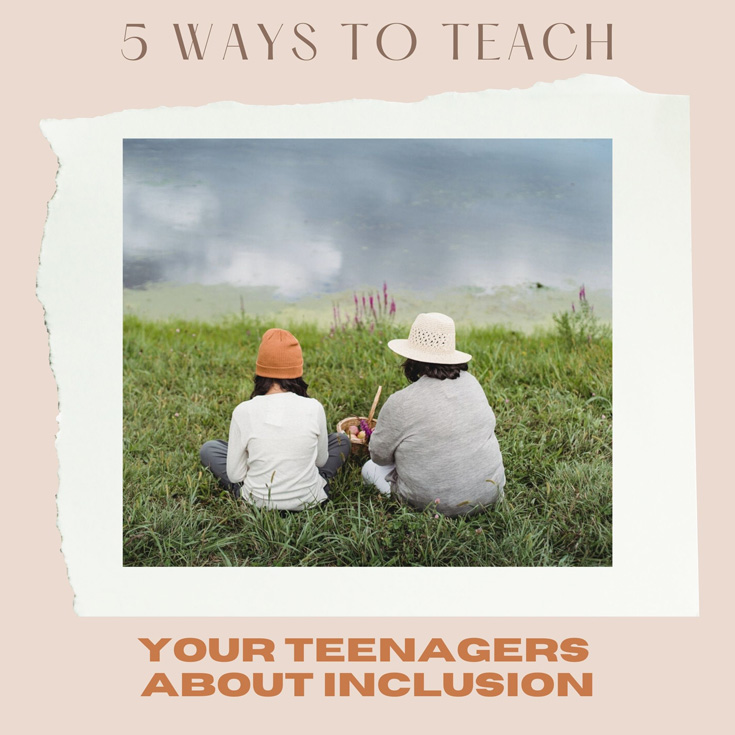Inclusion, allyship and other forms of advocacy have been a hot topic recently, as well they should be. Welcoming those who are different from you, offering kindness and being inclusive are not just a part of being a good person, but of creating a better world for everyone to live in, including your children and teens. Teaching your kids about inclusivity is one of the best things you can do to make them good citizens of the world, and one of the great things about it is that it’s never too late to start.

While there are a lot of resources out there about teaching young children to be inclusive, there isn’t as much information about encouraging the same behavior and education specifically in teens. Though it may come as a surprise, many of the ideas and techniques behind teaching people to be more inclusive can apply to all age groups. So when you’re teaching your teenager about inclusivity, here are a few of those tips you can keep in mind.
Model Inclusion in Your Life
Children are perceptive, and teenagers can often be particularly perceptive. While it may not seem like it makes a huge difference, teens should be exposed to all different kinds of people and different backgrounds. That’s why modeling inclusion and diversity in your own life can be a particularly effective method to teach your teenagers about inclusion. By having friends and peers from all different backgrounds, cultures, religions and ability levels, your kids can get used to the normalization of inclusion as a part of daily life.
Watch and Read Inclusive Content
While this tip is often given to parents of younger children, it can — and should — be adapted for parenting teens, as well. Teenage years are often the years when kids begin to understand and grasp more deep and complex concepts, and introducing them to films, books and news stories that aren’t just about representation, but education, can turn them into more responsible and inclusive citizens. There are so many literary, nonfiction and even young adult books that center around diversity that you can bring into your home, and when you do, your teens will be better informed about the world around them.
Invite Diversity Into Your Home
One of the best ways to raise your kids to be more inclusive is to make your home a more diverse place, not just for you, but for your kids as well. This means making space and accommodations for friends, family and partners of all abilities, backgrounds and religions in your house. Asking about things like dietary restrictions and accessibility before your teen has a friend over can make everyone feel more comfortable and included in your home. Making sure that your child knows they can bring home friends and partners of any ability, gender or background can set the tone for more inclusivity in your house, and in their lives.
Allow for Questions
While direct questions about someone’s background or situation may need a bit of tact, the idea and act of educating oneself about others is a great concept for teens to get acquainted with. If you happen to have answers to general questions they want to ask, allow them to ask them openly at home. If you don’t happen to have those answers, researching them together and helping to guide them through the educational process can be a great way to show them how to learn about others and their experiences. This can also help you ask the right questions in a sensitive way.
Teach Advocacy and Allyship
When it comes to teaching your teens and kids about inclusion, it should never stop at simply learning about it in concept. This is because one of the most important parts of being a person who values inclusion is about being someone who practices advocacy and allyship for those who need it. This means talking about how to stand up for those who need an ally, but not take up space for those who need to have their voice heard. Being an ally and an advocate is about striking a balance, and talking about it in your household can help your teens get a better understanding of that balance.
Teaching Your Teens to Be More Inclusive
Teaching your kids to be more inclusive is a process, and it’s one that continues for years. Whether you’re just getting started in their teenage years or you’re simply transitioning into more involved topics as their knowledge grows and changes, it’s never too early or too late to talk to your kids about how to be better allies and more inclusive people. Whether you’re reading books, talking about their questions or welcoming friends of all kinds into your home, teaching your teens about inclusion is a worthwhile effort for the world and for their futures in it.






Speak Your Mind